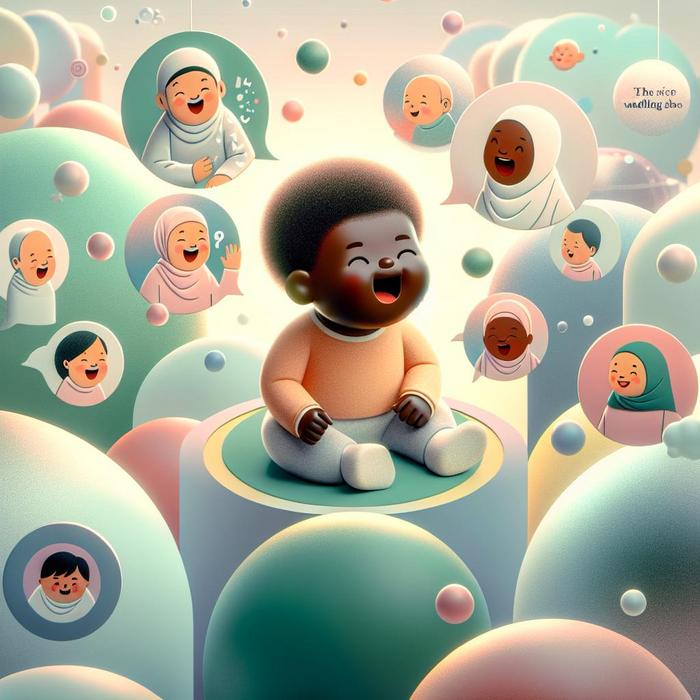The Delight of Baby Laughter
There’s something truly infectious about a baby’s laughter. It’s not just the adorable sound that can melt hearts and lighten moods, but the pure joyfulness it conveys. But beyond the endearing giggles and chuckles, have you ever wondered why babies laugh? The spontaneous laughter of babies may seem simple, but there’s actually intriguing science behind it.
Understanding the Early Stages of Baby Laughter
Most babies start laughing around the third or fourth month. This delightful milestone is a significant part of their development process. But what triggers this response? How do babies know what’s funny without understanding language or sophisticated humor? The answer lies in their instinctive response to stimuli.
According to research, babies often laugh as a response to sensory stimuli, such as tickling or blowing raspberries on their tummy. However, it’s not just physical contact that can prompt laughter. Unexpected things, like seeing mom or dad do something silly, can also make them giggle. At its core, baby laughter seems to be a reaction to novelty and surprise.
For a deeper dive into the fascinating world of baby laughter, you can explore this insightful article by a scientist who specializes in studying baby laughter.
Why Baby Laughter is Beneficial
Baby laughter isn’t just an adorable sound; it plays a crucial role in their growth and interaction with the world. Here are some compelling reasons why these jovial sounds are more than just cute:
- Social Connection: Laughing is a social response. When babies laugh, they’re communicating and connecting with their caregivers. This interaction is crucial for their social development.
- Motor Skills: Laughing involves a series of complex muscle movements, helping babies improve their motor skills.
- Emotional Development: Laughter helps babies express their emotions, contributing to their emotional development.
- Relieves Stress: Just like adults, laughter can help babies alleviate stress and feel better.
For further insights into why baby laughter is vital for their development, take a look at this Psychology Today article.
Exploring Theories about Baby Laughter
The scientific community has proposed various theories to understand babies and their laughter. Here are a few:
- Laughter as a Bonding Mechanism: Some scientists believe that babies laugh to bond with their caregivers. This theory suggests that the positive response from adults encourages babies to laugh more.
- Laughter as a Communication Tool: Others propose that babies use laughter as a communication tool before they learn to speak.
If you’re intrigued by the theories behind baby laughter, you might enjoy reading ‘The Laughing Baby: The extraordinary science of what makes babies happy’ available on Amazon.
While the mystery behind baby laughter continues to be a subject of scientific exploration, the joy it brings is undeniably universal. So, the next time your little one erupts into laughter, remember that you’re not just hearing a delightful sound – you’re witnessing a complex developmental process unfold. And if you’re interested in learning more about nourishing your baby, or how to unwind after a long day, make sure to explore our other articles as well.
The Unfolding Phenomenon of Baby Laughter
While the sublime joy of a baby’s laughter is widely cherished, the actual mechanics and purpose of this endearing behaviour are still enigmatic. Researchers have, however, unveiled some fascinating facets. Studies indicate that laughter in babies serves several vital functions, from forging social connections to enhancing their physiological development. Here’s an in-depth exploration of the intriguing enigma of a baby’s laughter.
Interpreting the Nature of Baby Laughter
Babies have a unique way of expressing their pleasure or excitement, with laughter being one such manifestation. However, their laughter is inherently dissimilar from adult laughter. For instance, babies do not comprehend humour, sarcasm, or irony, so their laughter emanates from minimalistic stimuli. A routine game of peek-a-boo, a funny face, or even a shaking object can send them into fits of laughter.
To expand your understanding of the concept, you can refer to this detailed piece of research published on researchgate.net penned by renowned baby laughter scientist, Caspar Addyman.
The Science Behind the Timing of Baby Laughter
Research suggests that baby laughter usually begins to appear between the third and fourth month. This timing is no coincidence, as it aligns with significant cognitive and motor milestones in a baby’s life such as recognizing faces and objects, and even making coordinated movements. This research paper, titled “The science of baby laughter,” elucidates this aspect further, available here.
The Power of Baby Laughter in Building Bonds
One of the most powerful attributes of baby laughter is the bond it creates. Whether it’s between the baby and the parent, siblings, or even strangers, a baby’s laughter can break barriers and establish an instant connection. Plunge into more analysis on this aspect in this article on independent.co.uk.
The Influences and Consequences of Baby Laughter
Baby laughter is a multifaceted phenomenon with several attributing factors and effects. Here are a few:
- Indicators of Mental Well-being: A laughing baby is often a sign of a comfortable and stress-free baby. Hence, it serves as an indicator of the baby’s mental well-being.
- Elicitation of Caregiving Behaviours: Baby laughter is a powerful tool to attract attention and elicit care from adults, thus ensuring their well-being and survival.
- Fuelling Cognitive Development: Laughter can be a reaction to novel stimuli, helping the baby learn about its surroundings.
- Resilience Building: As laughter helps alleviate stress, it equips the baby with essential coping mechanisms from an early stage.
The rich repository of articles written by baby laughter researcher, Caspar Addyman, provides further insights into these influences and consequences.
Baby laughter, while being a pure delight to witness and experience, is a complex process involving interplay of multiple factors. The intrigue behind it, however, becomes even more interesting once the science behind it is unravelled. As we continue to unravel the mysteries behind these heart-warming giggles, keep in mind that each laughter is a milestone in your baby’s growth and development worth celebrating.
For more such engaging explorations into various developmental aspects of infants, stay connected with us.

